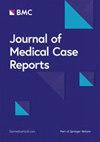Ibrutinib as treatment for Bing–Neel syndrome reclassified as glioblastoma: a case report
IF 0.9
Q3 MEDICINE, GENERAL & INTERNAL
引用次数: 0
Abstract
Glioblastoma is a highly malignant disease with limited treatment options. Ibrutinib, a covalent Bruton tyrosine kinase inhibitor, is an oral agent with manageable side effects used for hematological diseases including Waldenström macroglobulinemia. We present the case of a 69-year-old Caucasian male patient treated with ibrutinib for suspected Bing–Neel syndrome (BNS), which following a biopsy, was reclassified as glioblastoma. In December 2018, a 69-year-old Caucasian male patient was diagnosed with Waldenström macroglobulinemia. As the patient was asymptomatic, without bone marrow failure or high M-component count, watchful waiting was initiated. Due to increasing neurological symptoms, the patient, based on magnetic resonance imaging, was diagnosed with Bing–Neel syndrome in May 2019. The patient received different treatments before starting ibrutinib monotherapy in August 2019 due to disease progression, both on magnetic resonance imaging and clinically. The patient remained clinically stable for 7 months. In March 2020, the patient developed headaches, and both magnetic resonance imaging and a biopsy revealed glioblastoma IDH-wildtype. Treatment was changed in line with the new diagnosis, but the patient died at the end of 2020. We present a case in which a patient with glioblastoma IDH-wildtype remained clinically stable for 7 months when treated with ibrutinib monotherapy, which is similar to what would be expected for the standard treatment for glioblastoma. To our knowledge, this is the first patient receiving ibrutinib for a glioblastoma IDH-wildtype with a meaningful clinical outcome. Our case may therefore support previous nonclinical findings, indicating a therapeutic value of ibrutinib in patients with glioblastoma and support for further investigation of ibrutinib as a possible treatment for glioblastoma.伊布替尼治疗被重新归类为胶质母细胞瘤的Bing-Neel综合征:病例报告
胶质母细胞瘤是一种高度恶性疾病,治疗方案有限。伊布替尼是一种共价布鲁顿酪氨酸激酶抑制剂,是一种副作用可控的口服药物,用于治疗包括瓦尔登斯特伦巨球蛋白血症在内的血液病。我们介绍了一例 69 岁高加索男性患者的病例,患者因疑似宾-尼尔综合征(BNS)接受伊布替尼治疗,活检后被重新归类为胶质母细胞瘤。2018年12月,一名69岁的高加索男性患者被诊断为瓦尔登斯特伦巨球蛋白血症。由于患者无症状、无骨髓衰竭或高M成分计数,因此开始观察等待。由于神经系统症状不断加重,根据磁共振成像,患者于2019年5月被诊断为宾-内尔综合征。由于磁共振成像和临床上的疾病进展,患者在2019年8月开始伊布替尼单药治疗前接受了不同的治疗。7个月来,患者的临床症状一直保持稳定。2020年3月,患者出现头痛,磁共振成像和活检均显示为IDH-野生型胶质母细胞瘤。根据新诊断改变了治疗方法,但患者于 2020 年底去世。我们介绍了一例IDH-野生型胶质母细胞瘤患者在接受伊布替尼单药治疗7个月后仍保持临床稳定的病例,这与胶质母细胞瘤标准治疗的预期效果相似。据我们所知,这是第一例接受伊布替尼治疗的IDH-野生型胶质母细胞瘤患者,并取得了有意义的临床结果。因此,我们的病例可能支持之前的非临床研究结果,表明伊布替尼对胶质母细胞瘤患者有治疗价值,并支持将伊布替尼作为胶质母细胞瘤的一种可能治疗方法进行进一步研究。
本文章由计算机程序翻译,如有差异,请以英文原文为准。
求助全文
约1分钟内获得全文
求助全文
来源期刊

Journal of Medical Case Reports
Medicine-Medicine (all)
CiteScore
1.50
自引率
0.00%
发文量
436
期刊介绍:
JMCR is an open access, peer-reviewed online journal that will consider any original case report that expands the field of general medical knowledge. Reports should show one of the following: 1. Unreported or unusual side effects or adverse interactions involving medications 2. Unexpected or unusual presentations of a disease 3. New associations or variations in disease processes 4. Presentations, diagnoses and/or management of new and emerging diseases 5. An unexpected association between diseases or symptoms 6. An unexpected event in the course of observing or treating a patient 7. Findings that shed new light on the possible pathogenesis of a disease or an adverse effect
 求助内容:
求助内容: 应助结果提醒方式:
应助结果提醒方式:


